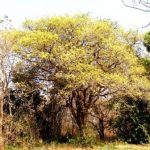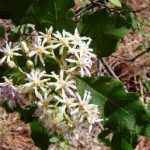TREE LIFE
November 2004
MASHONALAND CALENDAR
Tuesday 2nd November. Botanic Garden Walk. Meet in the car park at 4.45 for 5 pm. The topic for this walk will be the genus Rhus.
Sunday 21st November. Henry Hallam Dam close to Harare is a delightful spot offering unspoilt woodland, water birds and even, if we are lucky a snake or two. Mark will be busy with various other activities this month but Rob Burrett will step in to lead the walk.
Saturday 27th November. Mark’s walk is cancelled this month but we will have an extra walk early in 2005.
Sunday 5th December. The date for our Christmas Social is brought forward a little. We are very lucky to have been able to reserve the educational centre at the Botanic Gardens for the whole day. All facilities are available so this is a good venue. After the huge success of last years quiz Rob and Adele have compiled another for this year.
Please plan to bring some Christmas fare to share for tea, and bring your own lunch, a wine glass and a chair.
Tuesday 7th December. Botanic Garden Walk.
MATABELELAND CALENDAR
Sunday 28th November. The next meeting will be at Khami Ruins. Members to meet at 7.30 am at 27a Livingstone Road (JPs place) to share transport to Khami. For further information phone Jenny or Jonathan on 286529 Bulawayo, or e-mail JP kipepe@netconnect.co.zw
BOTANIC GARDEN WALK: 4 SEPTEMBER 2004
The last walk at the winter time of 11 a.m. on Saturday morning was kindly led by Meg Coates Palgrave, on the subject of Flowers and Fruits.
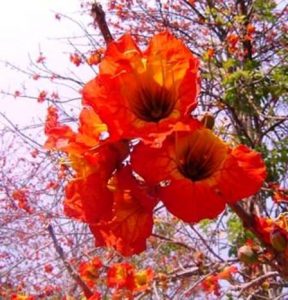
Fernandoa abbreviata. Photo: Bart Wursten. Source: Flora of Zimbabwe
A spectacular flowering tree early in the season is Fernandoa abbreviata. This has striking brownish-orange flowers which appear when the tree is virtually leafless. The specimen in the Botanic Garden originated from Malawi and nowadays is recognized as a species separate from F. magnifica which occurs in Zimbabwe.
The family is Bignoniaceae and members of that family often have 4 fertile stamens (i.e. they bear a normal anther containing pollen) and one sterile stamen, which produces no pollen. Such a stamen is known as a staminode. Sure enough the staminode was clearly visible in the case of Fernandoa.
The flowers are rather similar to the Sausage tree, Kigelia africana, which we saw later in the walk. Both species are pollinated by bats and the Sausage tree’s flowers also have 4 stamens and 1 staminode.
The Sausage tree bears its flowers on long pendulous racemes; Meg recalled that they had once counted 49 buds on 1 string. Meg mentioned how despite numerous flowers on each string, only one fruit per raceme actually matures. It is as if the tree doesn’t wish to put too much weight on each inflorescence.
Another tree with abundant flowers is the Quinine tree, Rauvolfia caffra. This has greenish flowers, leaves in whorls and produces abundant milky latex. Generally speaking it is a riverine tree of lower altitudes. It is quite often planted on roadsides. Meg remarked how it is often attacked by an insect which rolls up the leaves; in extreme cases the tree can be completely defoliated.
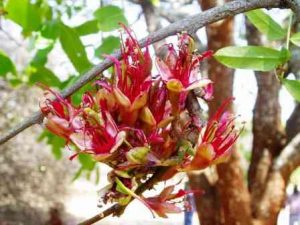
Schotia brachypetala. Photo: Mark Hyde. Source: Flora of Zimbabwe
A spectacular flowering tree is Schotia brachypetala. The flowers produce copious nectar so that the tree actually drips. The leaves are paripinnate with a few leaflets, a bit like the msasa (which of course belongs to the same family) but Schotia has leaves with a winged rachis. The flowers are pollinated by sunbirds and flies. In this area, Schotia is often found on termite mounds; elsewhere it may be a large riverine tree.
We looked at Lannea discolor. This is a species with male and female flowers on separate trees. It loses its leaves early in the year. Meg showed us its green underbark which enables it to photosynthesize even when leafless.
Strychnos spinosa (the Spiny monkey-orange) has the large well-known fruits which are a berry. The seeds of an Indian species, Strychnos nux-vomica are poisonous and contain strychnine. The leaves of all the strychnos spp. are 3-veined from the base or in fact from a point slightly above the base.
A very novel tree is Acacia drepanolobium, the Whistling tree. Not a Zimbabwean species, it occurs in E Africa. We once again managed to create a whistling noise artificially by blowing across the holes in the inflated spine bases.
All in all it was a most interesting walk, it lasted nearly 2 hours and we are very grateful to Meg for leading us.
-Mark Hyde.
CHIKUPU CAVES: 19 SEPTEMBER 2004
Our main outing for September was to Chikupu Caves in the Masembura Communal Land which was reached by travelling north of Harare through Chinhamora via Domboshawa.
I must apologise for the fact that the arrangements were not perfect. First, our vehicle was not working, then we assembled to meet various rotarians at Aon’s offices and it took a while to decide who was going with whom. Finally, it took us a lot longer to get there than I’d expected and it was not until 10.30 a.m., one hour late, that we arrived.
The turnout for the meeting was much higher than a normal Tree Society outing with about 35 people.
I’d never been to the cave before and the actual site is most impressive; tall walls of granite surrounding woodland in the foreground.
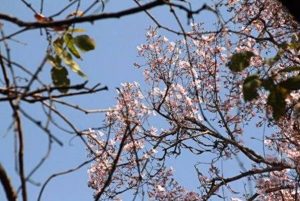
Stereospermum kunthianum. Photo: Mark Hyde. Source: Flora of Zimbabwe
Most striking in the woodland, in the higher part was a Pink Jacaranda, Stereospermum kunthianum, in full flower.
Reaching the cave required a climb up over somewhat slippery grass-covered rocks and, as someone remarked later, it was amazing that our not-always-young members managed to get up there and down again without mishap.
Once up at the cave, Rob Burrett gave a short but fascinating lecture about the cave. One interesting point he made was that the symbolism in the pictures was not necessarily easily interpreted by modern folk. A Christian picture of a lamb, as in the lamb of God, did not necessarily mean that the people kept sheep or hunted them!
With everyone safely down, the party fragmented into several small groups. The group I was with first visited the Pink Jacaranda and then explored the woodland at the base of the rocks.
The altitude here was just below 1400 metres, about 100 metres less than Harare and there was a lower altitude component present.
Here was Antidesma venosum the Tassel berry with its alternate leaves and pendulous tassels of flowers. Amongst the rocks was the characteristic species, Diospyros nummularia with its small round evergreen leaves. Another species typical of rocky sites was Elephantorrhiza goetzei, just producing its yellow flower spikes. Another evergreen species seen was Englerophytum magalismontanum (the Stem fruit).
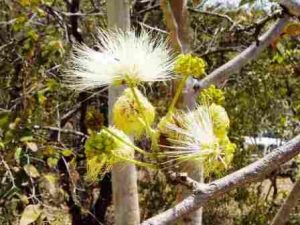
Albizia tanganyicensis. Photo: Mark Hyde. Source: Flora of Zimbabwe
Back to the car park for lunch. Nearby, growing in a crack of the rocks, was the very spectacular flowering Albizia tanganyicensis. The bark was pale (almost white), the tree leafless and the powder-puff heads very striking indeed.
After lunch, Meg led the group through woodland amongst rocks and a number of interesting plants were seen. A short selection of them is as follows.
Many Garcinia buchananii with yellow sap, Dalbergia nitidula, a fairly common legume around Harare. It is a shrub or small tree but often has distinctly climbing tendencies. The bark is dark and rough and the furry leaves are pinnate with alternate or sub opposite leaflets. It has small white pea flowers, as we saw on this occasion. Meg remarked that it often occurs in rocky places.
We also examined the galls on Syzygium guineense subsp. guineense (the Woodland Waterberry). An insect injects growth hormone and an egg, so that food is provided for the larva. The result is a peculiar inflorescence-like structure.
Galls are often associated with particular species and can be of assistance in naming plants. Dalbergia nitidula often has characteristic black spiny galls which look as if they may be the plant’s fruit but these are totally unlike the true fruit which are pods.
Another species seen was Erythroxylum emarginatum. This has leaves which are usually emarginate (i.e. they have an apical notch). Meg asked all present to put a leaf behind their tongue. No effect was noticed by anyone present this species does not have the effect that a related species, E. coca does, which produces cocaine.
Many thanks must go to Meg Coates Palgrave and Rob Burrett who were our leaders on this day.
-Mark Hyde
THE PETHERAM FILES – Continued.
Ancient Trees and Archaeology
Mythology, however, does not necessarily enter into all the seemingly extravagant stories of the venerable age of baobabs. The Kariba baobab, carbon-dated some years ago at our University, was calculated to be approximately 1000 years old. It was a tree 4.57 meters in diameter, which gives a circumference of 14.36 meters. G L Guy has written about trees on record exceeding 30 meters in circumference, and although there are all kinds of complexities that mitigate against a purely mathematical approach to estimates of growth rate including the fact that baobabs are known to decrease in diameter during long periods of drought it would not seem wildly irresponsible to assume an age of 2000-3000 years for a number of these old giants.
There is much of interest in the use of trees as structural timbers in the ever-intriguing stone ruins. Two of them figure in our better-known, later history.
From the Khami Ruins, timber posts form a passage near a staircase reputed to have led to a witch doctor’s lair were made of mopane (Colophospermum mopane). This well-known tree has a hallowed place in our history, because it was at the foot of one of them that Major Allan Wilson and his heroic men made their last stand near the Shangani River in 1893. On that tree, James Dawson soon afterwards cut the simple words To Brave Men, and the inscribed portion of the tree is now in the Bulawayo Museum.
[Comment 2002: Today, the Allan Wilson Memorial close to the Shangani River, stands in an area of mixed woodland, not mopane forest as it is so often described, and the nearest mopane is more than 100 metres away. The four trees closest to the memorial were (in 1988) two musasa (Brachystegia spiciformis), one mufuti (B. boehmii), and one wingpod (Xeroderris stuhlmannii). The latter, with a height of 19.5 metres and a diameter at ground level of 92.4 cm, was the largest of the four, but all were large enough to have been there at the time of the battle. This is not to say that Allan Wilson and his men did not make their last stand beneath a mopane, but the evidence indicates that the popular belief of a battle in mopane woodland may be open to question. If the tree on which James Dawson cut his inscription has been identified positively as mopane, it must be assumed that there was at least one mopane within the immediate site of the last stand. But it seems unlikely that there could have been such a complete change of the woodland constituents in such a dry area in as little as 100 years.From the Regina Ruins near Fort Rixon a log from the structure was found to be Combretum imberbe (leadwood), one of our hardest and heaviest woods. Our best-known living leadwood is probably the Missionary Tree just outside Bulawayo. It is a tree under which many missionaries and hunters sheltered while awaiting audience with Lobengula, and it is also close to Umvutsha Kraal, where the Rudd Concession was signed in October 1888.
There is another at Filabusi, reputed to have been the centre of the hustle and bustle of Zeederberg coach arrivals and departures.
Uses of Trees
To the Africans the uses of our indigenous trees were almost limitless. They provided shelter and warmth, fruits and beverages, potions and balms, poisons and cures, implements and weapons, ornaments and furniture, canoes and sleighs, ropes and clothing, glues, fodder, toys, and talismen; and they played and still play an important part in cultural rites and ceremonies.
To the pioneers, pre-pioneers, and early settlers they were also of importance. Aesthetic enjoyment of the silvery beauty of mangwe (Terminalia sericea), which the hunters, missionaries, and pioneers, generally, saw in abundance on their treks from the south, was coupled with appreciation of the quality of its timber, and the usefulness of a host of other woods. Grain, strength, workability, durability all featured in the selection of their requirements for wagon parts, bridges, mine props, railway sleepers, stockades, fence posts, and telegraph poles. Trekking through, or prospecting and camping in, remote areas, numbers of these hardy souls came to test, at close quarters, the edibility of fruits, roots, even leaves, and the medicinal properties of many species. The more observant relied on them as valuable indicators of soil, water, and game distribution.
Places with Tree Names
Not surprisingly, trees gave their names to some of our first towns and villages.
Terminalia sericea gave its Ndebele name, mangwe, to Zimbabwe’s very first, non-mission, white settlement. It was at Mangwe, about 100 km from Bulawayo, that Johannes Lee, the son of a British naval officer, and a very proficient hunter, made his home in 1866 on land 520 km of it granted to him by Mzilikazi. He acted as agent first to Mzilikazi and then to Lobengula and his house became the gathering place for travelers through the Mangwe Pass, which was the only practical route for wagons into Matabeleland before the Occupation. Thomas Baines and many others stayed there; in fact, Baines decorated the walls of Lee’s dining room with pictures of wild life. Selous passed through there in 1872.
Lee had a store at Mangwe, and there was a smithy run by Meyer, who was paid in ivory and ostrich feathers or rhino horn by the Matabele warriors when they brought in for repair the old-fashioned guns that some of them had acquired. A man named Zeisman ran a tannery. Altogether Mangwe seems to have been a hive of activity.
Lee planted wheat and potatoes in Zimbabwe more than 100 years ago! Also almond and peach trees supplied to him by the Rev Thomas Morgan Thomas of Inyati Mission, which had been established in 1859. Incidentally, the Rev Thomas’s initial horticultural activities had been a bit discouraging his very first crop of green peas in 1860 was promptly swiped by the Matabele!
During the Matabele War of 1893 a fort was built at Mangwe to guard the pass, and this was used as a laager in the uprising of 1896.
Lee retired to the Transvaal before the Occupation, and, sad to say, eventually died a rather embittered man, partly because his right to the land at Mangwe was not recognized.
As a tribute to those who risked the hazards of travel through Mangwe Pass in those days, there is a memorial (a granite obelisk) at the top of the pass, erected in 1954. The inscription reads: One hundred years ago, the first of the Missionaries, Hunters and Traders passed slowly and resolutely along this way Honour their Memory they revealed to those who followed, the bounties of a country they themselves might not enjoy.
There were trees in Zimbabwe that witnessed the unfolding of history, and Mzilikazi’s Indaba Tree was one of them. This was a specimen of Elaeodendron transvaalense standing at his capital Mhlahlandlela, about 21 km southeast of modern Bulawayo. The site is marked by a granite monolith bearing a brass plate inscribed with a tribute to Mzilikazi.
[Comment 2002: The bark of this species is reputed to be a powerful aphrodisiac, and so much bark was taken from the tree that it eventually died. It fell in 1987.]Lobengula, when he became king in 1870, first settled 5-6 km to the west of Mzilikazi’s Mhlahlandlela. His royal kraal was Zimbabwe’s first Bulawayo, named after the Gubulawayo near Eshowe in KwaZulu-Natal, from which Mzilikazi had been driven by Tshaka many years before. It was about 22 km south of the present city, and here he is said to have held court under a Pappea capensis. This tree was overwhelmed by a strangler fig, Ficus burkei, and no trace of the original tree remains visible.
In 1881 Lobengula ordered the destruction of his old kraal. His new Bulawayo was on the site on which State House stands today, and there he found another Pappea capensis, in his goat kraal, it is said his second indaba tree. This tree, I understand, is on the decline, but it is still there to be seen.
[Comment 2002: This indaba tree has had to have considerable corrective pruning to cut away dead wood, and a considerable portion of the original trunk is now kept in the Bulawayo Museum. In 1988 there were a number of fairly strong root suckers, which, hopefully, will maintain the old tree in reasonable health.]Mangwe was by no means the only place to borrow its name from a tree, although the others followed suit a good deal later.
Less than 30 km north of Mangwe, on the line of rail, is the village of Marula. Well before the end of the 19th century the German traveler, Edward Mohr, claimed to have made a very good preserve from ripe marula fruit mixed with wine, water, and honey but we were rather late on the scene with these discoveries. A grave unearthed not long ago, at a depth of about 5 metres in a cave in the Matopos, revealed the remains of a skeleton believed to be 15 000 years old. The presence of carbonized marula seeds in the same excavation can be taken only as circumstantial evidence, but it would seem that the fruit was already in use all those millennia ago.
The marula, Sclerocarya birrea ssp caffra, has links with one of the foremost of our more recent pioneers Thomas Murray MacDougall, of Triangle Sugar Estates fame. It was under a marula tree that MacDougall spent his first night on Triangle in 1912 a tree that became a favourite of his. His ashes repose in a casket in a rock slab under the tree.
Close to Marula, and also on the line of rail, is the well-known village of Plumtree. It was from a Plumtree School magazine of some 30 years ago that I read that when the railway survey party was travelling the new line in 1896 or 1897, naming railway stations, the mess cook, on arrival at this small, unnamed stop around midday, served a red pudding made from the umthunduluka, wild plum [better known today as the large sourplum]; and thus the name Plumtree was coined.
There are two trees called umthunduluka by the Ndebele people Ximenia caffra (large sourplum) and Flacourtia indica (governor’s plum). Both are fairly common in Zimbabwe, and the brilliant red of the large sourplum has led me to the conclusion that it was from this fruit that the railway survey party’s pudding was made. Mr Jack Reid, however, who knows the Plumtree area far better than I do, is convinced that Flacourtia indica was more likely to have been the tree involved.
[Comment 2002: A belief that Plumtree was named for the more common and more conspicuous marula also had its fair share of adherents among the early whites in the area who believed that the tree was a type of plum. In another of Dick Petheram’s files there are copies of correspondence he had on the subject with JB Clarke, at that time (1976) Headmaster of Plumtree School. The then Cook Matron at the school was Mrs Lily Campbell, daughter of Johannes Lee, who, as mentioned earlier in these notes, was given a grant of 520 km of land in the Mangwe area by Mzilikazi. Lee, according to Mrs Campbell, had told his children that the name Plumtree derived from a very big, very old, marula tree, which for many years towered over the railway siding . JB Clarke also noted that Mrs Campbell does not go along with the theory of a pudding made from umthunduluka unless it was intended as a mouth-wrinkling practical joke.]Between Plumtree and Marula is the railway siding of Syringa a fitting reminder that this exotic, Melia azedarach, was among the first to be introduced by the earliest English-speaking settlers in Zimbabwe. These were the founders of the London Missionary Society station at Inyati, established in 1859. It was on land granted for the purpose by Mzilikazi, within a few kilometres of the royal kraal occupied by the king at that time. It is thought that the Rev Robert Moffat brought the syringa seed with him from Kuruman.
[Comment 2002: The use of the name syringa for Melia azedarach should really be discouraged because this common name properly belongs to Syringa vulgaris of southeastern Europe. A more acceptable common name for Melia azedarach in Zimbabwe would be syringa berry, which is already widely used.]It may be of interest to recall that Moffat’s first visit to Mzilikazi in Zimbabwe was in 1854 the year before his son-in-law, David Livingstone, first saw the Victoria Falls.
The railway party, replete with red plum pudding, headed further northwest towards the next stop. By this time they must have established themselves as our first unofficial Tree Society, and the railway siding of Figtree was founded. The name speaks for itself. I understand that the particular tree from which the name was taken was a large specimen of Ficus glumosa, a well-known landmark where missionaries, hunters, traders, etc. had to wait for the permission of the king to enter his territory.
It was along that stretch of the railway line that the then world record for plate laying was achieved. The urgency was due to the rinderpest epidemic, which brought ox-drawn transport to a standstill.
Moving right away from Matabeleland we find another celebrated tree place-name Enkeldoorn (now renamed Chivu). Enkeldoorn literally means single thorn-tree, but it is a borrowed name, introduced by the Ferreira family, who settled there in 1893/94. It was originally the name of the family farm near Humansdorp in the Eastern Cape.
A tree name to which my attention was drawn by Mr Dix Airey is that of the Umvumela Dyke, which runs parallel to the Great Dyke. This is named after the mubvumira Kirkia acuminata. The most historic Kirkia in Zimbabwe is the Flag tree on the outskirts of Bulawayo, across the Bulawayo Spruit from present-day State House. When the British South Africa Company forces entered Bulawayo on 4 November 1893, they nailed a tattered BSA Company flag to a stick, and tied it to the branches of this tree.
In the Southeastern Lowveld
The southeastern lowveld also has its trees of historic renown, apart from MacDougall’s marula. There are several interesting old baobabs in the area, and my favourite, because it is associated with a storybook rogue of earlier days, is Bvekenya Barnard’s baobab at Manyande Pan. It stands at an old campsite on a trail that used to go through to Buffalo Bend. I confess to more than a sneaking regard for a man who, whatever his failings, had the audacity to lift with a flourish the international beacon at Crooks Corner to frustrate attempts from three territories to arrest him.
As that is not a very law-abiding note on which to end, you might care to reflect on the tamboti, Spirostachys africana, which supplied one of the structural timbers identified from the inner wall of the Great Enclosure at the Great Zimbabwe monument. A log of this lowveld species had been used as a lintel over a ground-level opening in the inner wall. Carbon dating of this wood was instrumental in providing a date for the early period of construction of the Great Enclosure.
In Conclusion
Well, life is full of contrasts. In the Rusape of today one of the town’s proudest features is an oak tree (Quercus robur) planted by Mrs Archer Ross, wife of the first Native Commissioner of the Makoni District, who was resident in Rusape from 1895 to 1909.
-Lyn Mullin To be continued.
MARK HYDE CHAIRMAN


